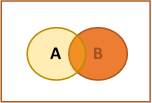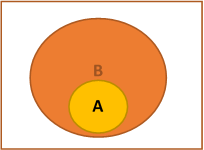![]()
![]()
![]()
Use LEFT and RIGHT arrow keys to navigate between flashcards;
Use UP and DOWN arrow keys to flip the card;
H to show hint;
A reads text to speech;
16 Cards in this Set
- Front
- Back
- 3rd side (hint)
|
set |
A collection of well-defined objects |
|
|
|
subset |
a sub-collection of items from a set |
A = {1, 2, 3, 4} B = {2, 4} ∴ B ⊆A |
|
|
nullset (empty set) |
a set containing no elements |
Ø |
|
|
Intersection of sets |
> 1 set contains common elements |
A∩B X = {a, b, c} Y = {d, b, a} ∴ X∩Y = {a,b} "and" |
|
|
Union of sets |
comprised of all elements in each set |
A∪B X = {a, b, c} Y = {d, b, a} ∴ X∪Y = {a, b, c, d} "or" |
|
|
Proper subset |
a sub-collection of items from a set that is not equal to the set. |
A⊂B X = {1, 2, 3, 4} Y = {1, 2} ∴ Y⊂X |
|
|
Sample Space |
set of all outcomes, denoted by Ω. |
Ω = {T, H} -->sample space for flipping a coin once. |
|
|
Experiment |
an activity or procedure that produces distinct, well-defined possibilities called outcomes. |
|
|
|
Event |
a subset of the sample space. |
Ω = {1, 2, 3, 4, 5, 6} A = rolling an even number [descriptive form] A = {2, 4, 6} [roster form] |
|
|
Disjoint sets |
two sets A & B are disjoint if A∩B = Ø |
sets that do not overlap in Venn |
|
|
The 4 Assumptions for Probability |
a function that assigns numbers to event which satisfies the following assumptions: 1) For any event A, 0 ≤ P(A) ≤ 1; 2) If Ω is the sample space, then P(Ω) = 1; 3) If A and B are disjoint, then P(A∪B) = P(A) + P(B); 4) If A1, A2,…,An is an infinite sequence of pairwise disjoint events (i.e. Ai∩Aj = Ø when i≠j), then P(∪ Ai), 1≤i≤∞ = ∑ P(Aj) 1≤i≤∞. |
|
|
|
Probability |
# of successes / total # of outcomes |
|
|
|
Complement of an event |
the set of all outcomes not in the event. |

|
|
|
Complement Probability Property |
P(A) = 1 - P(A) |
Ω = A∪A' = 1
|
|
|
Union of sets Property |
For any events A & B, P(A∪B) = P(A) + P(B) - P(A∩B) |

|
|
|
Monotonicity Property |
If A⊂B, then P(A) ≤ P(B) |

|

